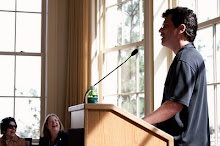In another Janeite online discussion, I made the following comments today:
I claim that Austen's novels are anamorphic--two parallel fictional universes--and so there are TWO Mrs. Allens: one is the fool who is indeed a comic character, in all the ways that you, Ellen, and most everybody else see her. But….I also claim that the OTHER Mrs. Allen, the Mrs. Allen of the shadow story, is only PRETENDING to be a fool—she’s playing a role and is actually a woman who gets what she wants out of a sterile marriage to a much older rich man, the way that many aristocratic women of her day did--following the advice that was given to Lady Caroline Lamb that LCL famously did NOT follow---do what you want….as long as you do it discreetly. THAT is the shadow Mrs. Allen to a tee, I claim.
Which leads to the following narration in NA:
"It is now expedient to give some description of Mrs. Allen, that the reader may be able to judge, in what manner her actions will hereafter tend to promote the general distress of the work, and how she will, probably, contribute to reduce poor Catherine to all the desperate wretchedness of which a last volume is capable-whether by her imprudence, vulgarity, or jealousy-whether by intercepting her letters, ruining her character, or turning her out of doors."
In the overt story, I freely acknowledge that this passage is meant to be taken at face value, meaning that we are NOT to really think that Mrs. Allen is actually going to do any of those stock Gothic-villain actions. HOWEVER, in the shadow story, what I suggest is that the narration about Mrs. Allen is a giant clue that it is MRS. ALLEN who is going to be instrumental in bringing about each of those three "Gothic" intrigues in the alternative shadow story of the novel.
We are being prompted by JA to read between the lines in the rest of the novel, and to try to spot the moment when Mr. Allen DOES intercept one of Catherine's letters, and exactly how Mrs. Allen DOES try to ruin Catherine's character, and, in so doing, when she DOES cause Catherine to be turned out of doors. I.e., I am suggesting that this passage is a hint from JA that it is Mrs. Allen who is the "voluntary spy" who takes steps offstage in deliberately provoking the gullible, quick-tempered General Tilney into throwing Catherine out of the Abbey. Now, what Mrs. Allen's motivation might be in taking such actions is a matter of interpretation of the shadow story beyond the scope of this post.
Much the same kind of argument was made in regard to Pride and Prejudice over ten years ago by a Norwegian biologist named Kim Damstra (Kim’s idea was then spread widely by John Sutherland who put it front and center in his book “Who Betrays Elizabeth Bennet?”). Damstra claimed that Charlotte Lucas plays the same trick I attribute to Mrs. Allen, in provoking Lady Catherine into high dudgeon, which boomerangs on Lady C, when her interventions with Darcy and Lizzy paradoxically push Darcy and Lizzy together.
And…I claim that Lucy Steele does exactly the same thing in S&S, "innocently" provoking Mrs. Ferrars into high dudgeon, which leads Mrs. F to disinherit Edward and vest Robert’s inheritance---which is EXACTLY what Lucy wanted in the first place, because Lucy ALREADY had Robert wrapped around her finger!
I claim JA loved to repeat these motifs of seemingly powerless women working behind the scenes in her shadow stories, to deploy Iago-like manipulative skills to induce the powerful to perform like inadvertent puppets.
Cheers,
ARNIE
Popular Posts
- Deirdre Le Faye & Me: "I am a scholar, she is a scholar: so far we are equal"
- Darcy's "We neither of us perform to strangers": a Radical New Interpretation
- The Hunger Games’s Veiled Allusion to Shakespeare’s Titus Andronicus
- Rick Santorum would have been the worst person in the world to Jane Austen too!
- August Wayne Booth in Once Upon A Time: Jane Austen Really IS Everywhere in 2012!
- 20 shades of hero/villain Mr. Darcy
- Can Jane Austen forgive Marianne?
- Miss Bennet, Elizabeth, Lizzy, Eliza: who calls her what....and why
- The Great Gadsby: an overnight lesbian feminist ‘comedy’ sensation 10+ years in the making (& 3 millenia overdue)
- Austenland: The Movie was Fun, but the Novel was Better [SPOILER ALERT as to both]
Subscribe to:
Post Comments (Atom)

No comments:
Post a Comment